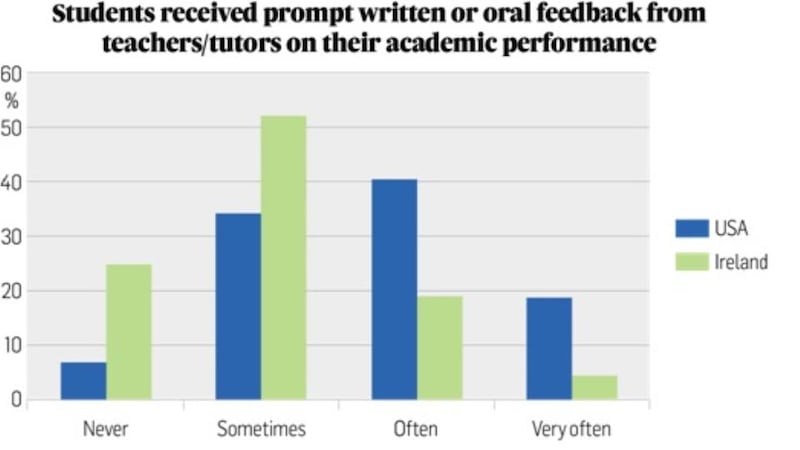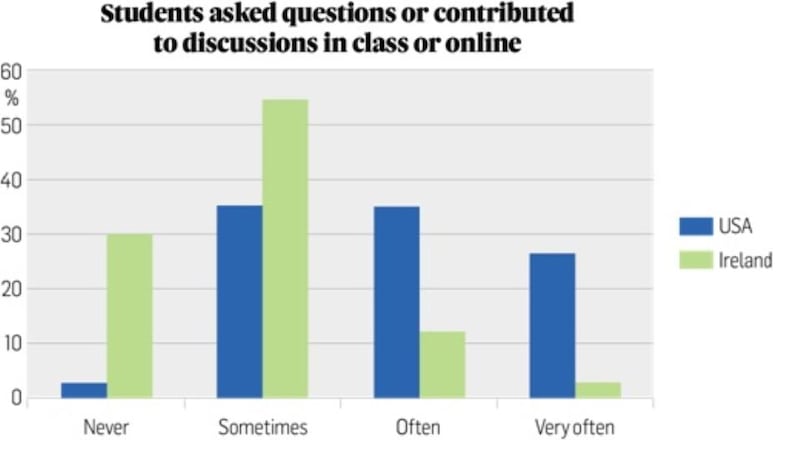It takes a confident fresher to ask a question of their lecturer in week one. By week two only the brave are willing to share their independent thoughts with a packed lecture theatre (especially with all those new friends and that person they fancy sitting nearby). But what about by month six?
A survey carried out by Dr Paul Donovan at the School of Business in Maynooth University found 30 per cent of students at this juncture in their college life had never asked questions or contributed to discussions in class or online.
This won’t come as much surprise to anyone working in higher education in Ireland, but the finding contrasts greatly with the US where more than half of first years “often or very often” asked questions or contributed to discussions in class.
For his study, Donovan looked at the results of the US National Survey of Student Engagement (NSSE), the international benchmark for such research, and put the same set of questions – with certain amendments for an Irish audience – to 150 first-year business students.
Comparisons were then made on engagement issues such as participation in class, intellectual activities, labs and tutorials, reading and writing, examinations, self-guided study and general satisfaction with the university.
“Irish students differed from their US counterparts in several areas, most notably in contributing in class, preparation for class and communication with their lecturers,” Donovan explains.

More passive
“US students were much more likely to have made a presentation in class and to ask questions in class, whereas Irish students declared themselves to be much more passive in class.
“Irish students differed also in their preparation for the class sessions in that they were twice as likely to arrive in class without having prepared for their lectures: 32 per cent said that this happened often or very often and only one in four said it never happened.
“Communication with lecturers also seems to be a point of difference between the two systems. US students were much more likely to have discussions with tutors on issues such as grades, career plans and ideas from readings outside of class. US students were also much more likely to receive oral or written feedback from their tutors than their Irish counterparts.”
Donovan says some of the differences are “obviously” culturally-based. “When US students visit Irish universities, lecturers immediately notice that they are more participatory in class than the natives . . .
“People learn in different ways, however, and a reflective style of learning might be just as effective even if it is less participatory.”
Seán O’Reilly, project manager of the Irish Survey of Student Engagement (ISSE), which is due to publish its second annual findings in November, agrees that cultural differences play a part.
“A very high proportion of students in the US live on campus, and if you are talking about engagement that does generate a very significant difference in results.”
However, he advocated a cautious approach to making comparisons between jurisdictions. The ISSE, which involves surveying more than 27,000 students from 30 higher education institutions, is based on an Australian research template, which in turn was adapted from the NSSE questionnaire.
Next year, however, the US survey is being adjusted, which will make direct international comparisons possible. In addition, the UK is introducing a voluntary student engagement survey, which will act as a more relevant comparator for Ireland.

Low interaction
According to O’Reilly, however, one thing which can be said is “across the board, student-staff interaction for first years in Ireland is lower than other groups [of students] and lower than other groups internationally”.
Last year’s edition of the ISSE showed a somewhat higher level of engagement than Donovan’s study. Almost 8 per cent of first years said they never contributed to discussions in class, tutorials, labs or online, while half said they sometimes did.
However, 41 per cent said they never discussed grades or assignments with staff, and 61 per cent said they never discussed ideas from coursework with teaching staff outside of class.
Almost a quarter of first years said they “never” received timely feedback from academic staff. Nonetheless, impressions of lecturers were largely positive.
“It seems students may not expect to interact significantly with their lecturing staff,” says O’Reilly, and this may be a particular Irish phenomenon – based on students’ experience at second level.
Highlighting this point, Donovan says: “We know that first-year Irish students have just emerged from the grind of the Leaving Certificate and may see first year in college as a time to relax and enjoy life. Certainly Irish universities may not help the cause by excluding the first year’s results from the final grade achieved by students in their degree.
“There are other issues which may intervene here such as the increasing practice of students working to finance their studies. However, anecdotal evidence suggests this is even more prevalent in the US than in Ireland.”
The “massification of education in this state” is another factor, he says, and higher class sizes can only diminish levels of communication.
“Lecturers are promoted for being good researchers and not for engaging with students,” Donovan says. “Irish lecturers, with large classes, may be protecting their own careers by limiting access to them by students.”

Poor engagement
Another theory for the relatively poor engagement of Irish students in lectures is lack of confidence, something cited by columnist Emer O'Toole in a recent article. Reflecting on her experience teaching in North America, she wondered whether Irish habits represented a "postcolonial hangover".
But Kevin Donoghue, president of the Union of Students in Ireland, who was involved in developing the ISSE, says American students can't be compared directly with their Irish counterparts. "The American education system is not an open system, and there's a different type of student," he says, citing the higher fees involved in the US.
“The typical Irish student is quite engaged,” Donoghue adds. “It does take a bit of encouragement and a lot of that comes down to the teacher. But once you get that initial push you are good to go.”


















